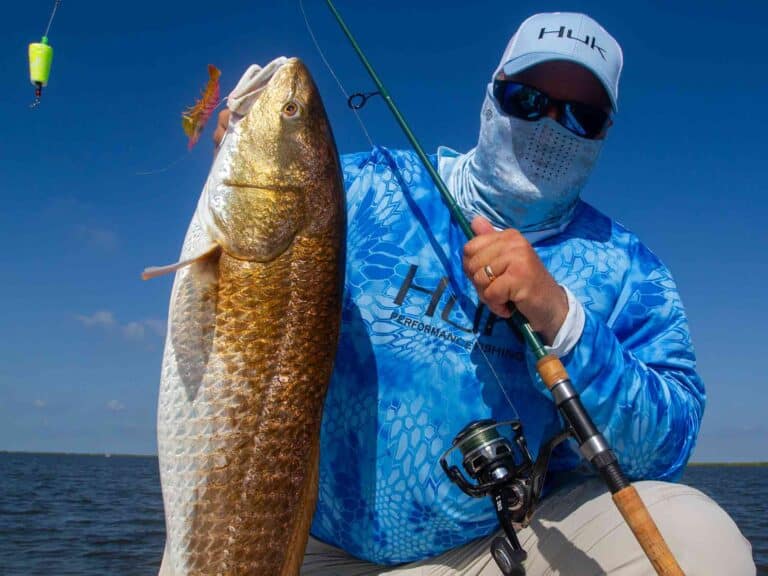
Bunker were scattering all over the place when we arrived off Asbury Park and joined the fleet of 20 boats drifting off the Convention Hall. The sight of so many big baitfish being chased by large and hungry predators, plus the fact that every boat contained anglers with bent rods, spurred us into immediate action. The snag hooks flew, and in short order we were reeling in shoe-sized bunker, which we planned to transfer to circle hooks and deploy on conventional gear. But I never got the chance, as an aggressive striper had other plans for my bait, inhaling it before I could get it near the boat.
After a long run, the bass tired and Hans Kaspersetz used his BogaGrip to lift the 38-pounder aboard. The snag hook had lodged in the gills, so we decided to keep the fish. Fortunately, only one other striper of the 15 I caught in the next few hours managed to grab a snagged bunker before I could transfer it to a circle hook, so I was able to release them in good shape.



(top) Hans Kaspersetz displays an “average-size” striper that was caught beneath a bunker school last June. (middle) The fleet gets busy off the Asbury Park Convention Hall during last season’s hot bite. (bottom) These nervous bunker are a sure sign that hungry predators are close by.|
The easiest way to catch stripers under bunker is simply to snag a bait and let it swim with the school. Of course, the treble hook used for snagging often results in deep-hooked fish, which is fine if you’re planning to call it quits after filling a limit. However, when the action is hot, I prefer to rig the bait on a big circle hook after first snagging it with a treble, as the former is less likely to harm any fish I intend to release.
Big-Bass Bonanza
Kaspersetz and Mark Roy, on whose 31-foot Ocean Master we were fishing, also hooked fish on almost every drift that day. Fortunately,the fog kept the fleet to a manageable number, which no doubt contributed to the steady action. The majority of bass ran from 25 to 32 pounds, although Kaspersetz and I both released 40-pounders. Best of all, the predators under those bunker were mostly all bass, as we only caught one bluefish on our last drift. More big blues arrived in the following days, but stripers continued to dominate, which hasn’t been the case in recent years.
I wish I could claim that the great action we experienced was a result of our fishing prowess, but when conditions are right and the bunker are thick, there’s not much need for expertise. In this case, it was almost impossible to throw a treble hook into the seething mass of bunker without snagging a bait, and a bass would usually grab it within moments if we didn’t rush it back to the boat for rehooking. Of course, it’s not like that all the time.
| ### Snag a Fresh One! |

¿| |Snagging bait is usually simple once you learn how to spot the riffled water created by a school of bunker. Weighted treble snag hooks can be cast over the bunker school and allowed to sink about halfway to bottom, then retrieved in sharp sweeps, allowing the hook to drop back between each sweep. Remember, there are many more fish below the ones you see on the surface. When the bunker schools are small, it’s difficult to snag baits, but most of the time, especially early in the run, they’re available on demand. We simply snag them as necessary or just keep a few in the live well for when we drift out of the school while fighting a bass and want to put out another bait. – Al Ristori

Surface boils indicate the location of bunker under attack by feeding bass and bluefish. (inset) This live bunker is rigged with an Eagle Claw Black Pearl circle hook and ready for deployment.|
I’d have to thank the fog for giving us that great day last June on Friday the 13th, as there had been a lot of boats chasing the schools in the days before. Our late start that morning didn’t make a bit of difference due to the relative lack of boat traffic, and the only thing unlucky about the day was that we only had a few hours to fish. I later learned that the action didn’t slack off at all after we left, and even surfcasters working from the Asbury Park jetties were catching 40-pounders during what was probably the best single day of big-bass action along the northern Jersey Shore in more than three decades!
Getting a late start the next morning did make a big difference, since fog was not a factor and everyone who was out there just after dawn scored quickly. We encountered a big fleet as we approached the first bunker schools off Asbury Park, but slow-trolling a live bait produced a 22-pounder for Nick DeNucci. Then a call from friends put us into a flurry of action just south of Shark River Inlet, where DeNucci hooked a couple of 30-pounders and I released a 36-pounder. After that it was a real struggle in the ever-building crowd, which put a damper on the action.
We experienced much the same thing when Kaspersetz, DeNucci and I joined John Messina on his Halley’s Comet, a 23-foot Regulator, for a few hours of fishing on Father’s Day morning. We hooked a couple bass from a small pod of bunker off Spring Lake, but found 50 boats already fishing the massive school off Asbury Park by 6:15. Rather than fight the crowds, we ran south to seek out the smaller bunker schools, which we generally prefer to target anyway.
The schools we found off Bay Head, south of Manasquan Inlet, weren’t even good enough to provide snagged baits on demand, although there were a few bass and big blues around them. I let the other three anglers fish live baits while I drifted the head of a bunker that had been cut in half by a bluefish. That bait produced a 38-pounder while my partners fought off the blues. By the time we left at 10:00 a.m. we had tallied eight nice bass – not a bad score on what could have been a tough day if we’d remained with the crowd.
B-Day Invasion
| ### Rigging Bunker | ||
| Rigging bunker can be as simple as you like, especially since stripers are rarely leader-shy. My leader setup involves a swivel tied to about three feet of 40- to 60-pound fluorocarbon. On the other end I tie on the largest non-offset circle hook available – usually an 8/0 or 9/0 Eagle Claw Black Pearl model. Live bunker are usually hooked through the nose or lips for drifting, but can be hooked in other ways for use on the surface. Lip-hooking seems to work best with drifted bunker heads. Chunks should be hooked very lightly, top or bottom, so the circle hook can do the job of setting itself. Large sinkers are rarely required, even in strong currents, as most of this fishing takes place in fairly shallow water. – Al Ristori |
The annual bunker migration off northern New Jersey occurs from early June to early July, providing what may be the best opportunity of the year to catch a trophy bass. A huge school of bunker, like the one that virtually took up residence within a quarter mile of Asbury Park and Deal last June, isn’t as common as having many smaller schools spread out over miles of coast.
One reason last year’s fishing remained so good was because the bait stayed well within a half mile of shore. Although the gigantic factory seiners can’t set their nets in state waters, the smaller bait seiners can net bunker as close as 6/10 of a mile from shore. The latter often wipe out a large portion of the stock in short order, but last June’s bunker stayed right where anglers wanted them. However, the intense fishing pressure soon took its toll on the number of fish, and it eventually became necessary to move around to various schools in order to find a big bass.
This is when technique becomes important. Without heavy competition from other bass, stripers seem to become a lot more choosy. If letting a hooked bunker swim around in the school doesn’t draw hits, try using a bit of weight to get it down. And when bluefish dominate, it may be time to bring those snagged bunker elsewhere – such as the jetties. Anglers have been casting live baits into the jetties for decades, and a great many big bass have been caught that way. Bunker can also be transported to other areas, such as Shrewsbury Rocks, with excellent results.
Bait on the Rocks

SWS Offshore Editor Gary Caputi looks on as Captain Terry Sullivan helps him boat a striper off the Jersey Shore.|
“The Rocks,” as local anglers refer to this area of rough bottom off Monmouth Beach, probably serves as the best bass structure west of Montauk. Trollers have long regarded this as a prime area to ply their trade, but drifting bunker is an even deadlier technique when the bait is available.
George Poveromo found this out in June 2002 when he filmed an episode of his TV show at The Rocks with Captain Terry Sullivan. It was a flat-calm morning, and the fishing couldn’t have been any better. That same day, I fished the area with Tom Fote, the governor’s appointee commissioner for New Jersey to the Atlantic States Marine Fisheries Commission, on my 28-foot Aquasport, Sheri Berri II. We snagged baits off Asbury Park and, with no one else around, couldn’t resist the temptation to troll one past a nearby jetty, which produced a 25-pounder.
However, that turned out to be a waste of time, as upon arriving off Monmouth Beach we saw that every boat was hooked up. Live bunker were being assaulted instantly in 20-foot depths by big bass and jumbo blues, although the latter did most of the damage.

The author poses with a 40-pounder that inhaled a slow-trolled live bunker at Shrewsbury Rocks.|
At one point I watched my bait get torn up by two blues. As the head began to sink, it was engulfed by a striper of about 35 pounds. I fought the bass to boatside, but the bluefish-damaged leader broke as Fote was trying to grab the fish’s mouth with a BogaGrip. That’s when we got smart and switched to chunks, which were hit just as fast and provided more and better hook-ups than whole, live baits. When stripers are feeding on bunker, even small pieces of bait can attract them.
By late June of ’04, the main bite had moved to Shrewsbury Rocks. The action wasn’t wild, but we were able to take a nice pick of bass as long as the current was running. Eventually, The Rocks shut off completely as July rolled around and the bass and bunker moved on, leaving Jersey Shore anglers with memories of what had certainly been an amazing run.
What’s interesting is that spring striped bass fishing in Raritan Bay has been so good in the last few years that the shore fishery often gets overlooked. However, when it comes to catching stripers, especially big ones, there has been no better time to do it than during the June bunker migration.









